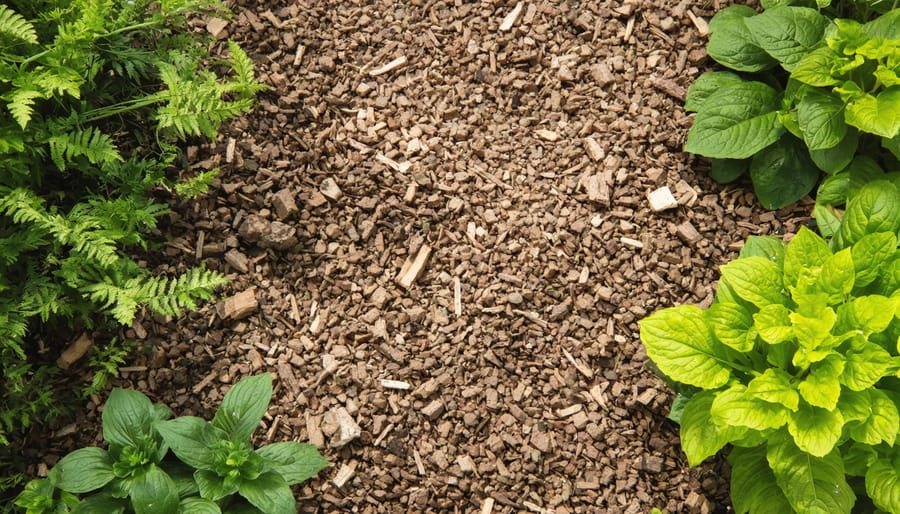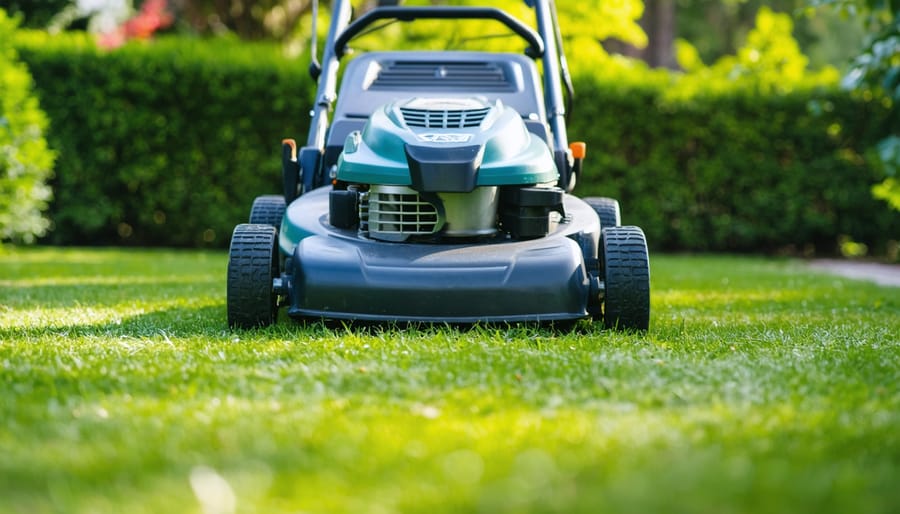Transform your garden into an eco-warrior’s paradise by layering grass clippings and fallen leaves as free, nutrient-rich mulch that naturally decomposes while delivering essential water conservation benefits. Shred cardboard and newspaper into biodegradable mulch sheets that effectively suppress weeds while breaking down to enrich soil structure. Source locally produced compost or wood chips from tree services to create a sustainable mulch barrier that reduces waste and supports your regional ecosystem. Mix pine needles with straw mulch around acid-loving plants, creating an optimal growing environment while utilizing readily available natural materials that would otherwise end up in landfills.
Choose these earth-friendly mulching alternatives to synthetic options, and watch your garden thrive while minimizing your environmental impact. Not only will you save money and reduce waste, but you’ll also build healthier soil that naturally resists pests and disease, creating a truly sustainable growing space that works in harmony with nature.
What Makes Mulch Eco-Friendly?
Natural vs. Synthetic Mulch
When choosing mulch for your garden, you’ll typically encounter two main categories: natural and synthetic options. Natural mulches include materials like wood chips, bark, straw, leaves, and grass clippings – all of which come directly from nature. These materials break down over time, enriching your soil with organic matter and nutrients while supporting beneficial microorganisms.
Synthetic mulches, such as rubber chips or landscape fabric, offer longer-lasting coverage but don’t provide the same soil-enriching benefits. While they might seem cost-effective due to their durability, synthetic options can potentially leach chemicals into your soil and don’t contribute to the natural ecosystem of your garden.
From an environmental perspective, natural mulches are the clear winners. They’re biodegradable, renewable, and often locally sourced – sometimes even from your own yard! Many natural mulches are actually byproducts of other industries, like bark from lumber processing or cocoa hulls from chocolate production, making them sustainable choices that help reduce waste.
While synthetic mulches might last longer, the environmental benefits of natural options make them the better choice for eco-conscious gardeners. They improve soil health, support local ecosystems, and complete the natural cycle of nutrient return to the earth.
Local and Renewable Sources
One of the most environmentally responsible choices you can make when mulching is to use materials sourced from your local area. Local materials not only reduce transportation emissions but also support your regional ecosystem. Consider reaching out to nearby tree services, which often have wood chips available for free or at a low cost. These fresh chips come directly from tree maintenance in your community and provide an excellent mulching option.
Leaves, grass clippings, and pine needles from your own yard are perfect examples of renewable mulch sources right at your doorstep. If you have access to a local farm or stable, straw and aged manure make excellent mulch options that support local agriculture while improving your soil.
Many municipalities offer free compost and mulch created from collected yard waste. This closed-loop system turns what would be waste into a valuable gardening resource. By choosing these local options, you’re not only saving money but also participating in sustainable waste management practices.
Remember to check if your community has a wood recycling program – these often produce high-quality mulch from fallen trees and pruned branches, making excellent use of materials that might otherwise end up in landfills.
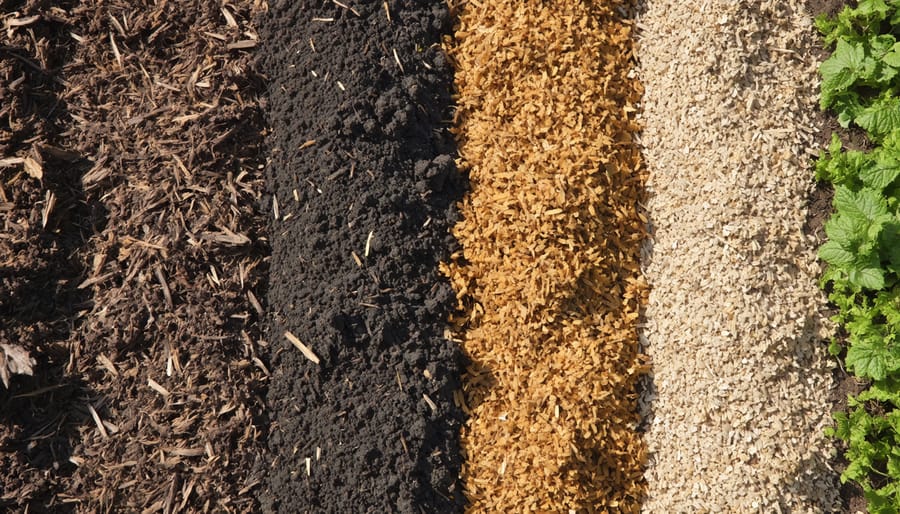
Best Eco-Friendly Mulch Options
Grass Clippings and Leaves
Transform your yard waste into garden gold by using grass clippings and leaves as mulch. This sustainable approach to lawn maintenance not only reduces waste but also provides valuable nutrients to your soil. When using grass clippings, apply them in thin layers (about 1-2 inches thick) to prevent matting and allow proper air circulation. Fresh clippings are high in nitrogen and break down quickly, feeding your plants as they decompose.
Fallen leaves make excellent mulch material too, especially when shredded. Run your lawn mower over dry leaves to create smaller pieces that won’t mat down or blow away easily. This leaf mulch is particularly beneficial for woodland gardens and around shrubs, helping to mimic natural forest floor conditions. Layer your leaf mulch 2-3 inches deep, keeping it away from plant stems and tree trunks to prevent moisture-related issues.
Both grass clippings and leaves are free resources that naturally improve soil structure, regulate soil temperature, and support beneficial organisms in your garden. Just ensure they haven’t been treated with herbicides or pesticides before using them as mulch.
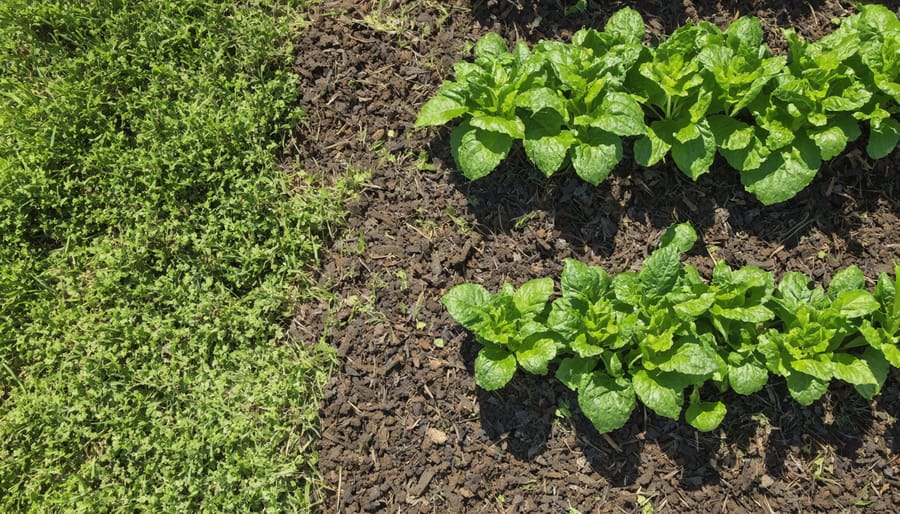
Composted Wood Chips
Composted wood chips offer a sustainable and effective mulching solution that benefits both your garden and the environment. These chips, typically made from recycled tree trimmings and lumber waste, break down gradually to enrich your soil with valuable organic matter. As they decompose, they release essential nutrients while maintaining excellent moisture retention properties, helping you reduce water usage in your garden.
To apply composted wood chips effectively, spread them in a layer 2-3 inches thick around your plants, keeping the mulch about 2-3 inches away from plant stems and tree trunks to prevent rot. One of the greatest advantages of wood chip mulch is its longevity – it can last up to two years before needing replacement, making it a cost-effective choice for larger garden areas.
The natural appearance of wood chips adds an attractive, rustic look to your landscape while suppressing weed growth and regulating soil temperature. They work particularly well around trees, shrubs, and in perennial beds. For best results, use wood chips that have been partially composted, as fresh chips can temporarily deplete soil nitrogen as they decompose. Consider sourcing your wood chips from local tree services or community composting facilities to maximize the environmental benefits and support circular economy practices.
Straw and Pine Needles
Both straw and pine needles are excellent natural mulching options that offer unique benefits for different garden types. Straw works wonderfully in vegetable gardens and around fruit trees, creating a protective layer that helps retain moisture while allowing proper air circulation. When selecting straw, opt for clean, seed-free varieties to prevent unwanted growth in your garden beds.
Pine needles, also known as pine straw, are particularly effective in acidic-soil-loving plants like azaleas, rhododendrons, and blueberries. They break down slowly, providing long-lasting coverage and naturally increasing soil acidity over time. Their interlocking nature helps them stay in place, making them ideal for sloped areas where other mulches might wash away.
Both materials are highly sustainable choices. Straw is a renewable agricultural byproduct, while pine needles can often be collected for free from local pine forests or purchased from sustainable sources. Apply either material in a 2-3 inch layer, making sure not to pile it against plant stems or tree trunks. These natural mulches will gradually decompose, enriching your soil with organic matter and supporting a healthy garden ecosystem.
Living Mulch Options
Living mulch offers a dynamic approach to garden protection through the use of ground cover plants. These living plants not only protect your soil but also contribute to your garden’s biodiversity and visual appeal. Creeping thyme, white clover, and creeping jenny are excellent choices for sunny areas, creating a dense mat that suppresses weeds while adding beauty to your landscape.
For shaded areas, consider options like sweet woodruff or dead nettle, which thrive in low-light conditions while providing excellent ground coverage. These plants not only protect the soil but also help retain moisture and prevent erosion, making them perfect companions for trees and larger shrubs.
One of the biggest advantages of living mulch is its self-sustaining nature. Once established, these plants continue to grow and spread, providing permanent soil protection without the need for annual replacement. They also contribute to soil health by fixing nitrogen (in the case of clover) and adding organic matter as their leaves naturally decompose.
When selecting living mulch, choose species that complement your existing plants and won’t compete too aggressively for resources. Consider factors like growth rate, maintenance requirements, and climate compatibility to ensure success in your garden.
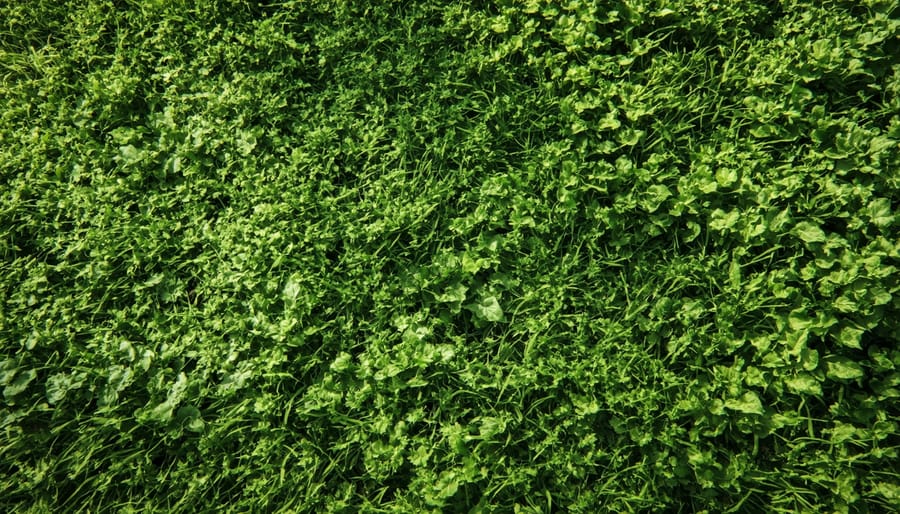
Application Techniques
Timing and Preparation
The best time to apply eco-friendly mulch is during the early spring or late fall when soil conditions are ideal. Spring mulching helps suppress weed growth before the growing season kicks into high gear, while fall application protects plant roots during winter. Before laying mulch, it’s essential to prepare your garden properly to maximize its benefits.
Start by clearing the area of weeds, debris, and dead plant material. This gives your mulch a clean foundation and prevents unwanted plants from growing through. If you’re working around existing plants, gently pull any weeds by hand to avoid disturbing their root systems. Next, ensure your soil is adequately moist – combining efficient garden watering with proper mulching will help maintain optimal soil conditions.
For best results, loosen the top layer of soil slightly with a garden fork or tiller, especially if it’s compacted. This helps the mulch integrate better with your soil over time. If you’re planning to add compost or organic fertilizers, do this before laying your mulch. Apply these amendments directly to the soil and work them in gently.
Consider the weather forecast before mulching – avoid applying during heavy rain periods as wet mulch can become compacted and less effective. Similarly, if you’re using fresh organic materials like grass clippings or leaves, let them dry slightly before application to prevent matting.
Layer Thickness and Coverage
Proper application of eco-friendly mulch starts with understanding the right thickness for different areas of your garden. For most applications, aim for a layer between 2 to 4 inches deep. This depth is ideal for moisture retention and weed suppression while allowing adequate air circulation to the soil beneath.
When applying mulch around trees and shrubs, maintain a 3-inch gap between the mulch and the trunk or stem to prevent rot and pest problems. Avoid the common mistake of creating “mulch volcanoes” around trees, as this can lead to serious health issues for your plants.
For vegetable gardens and annual flower beds, stick to a slightly thinner layer of about 2 inches. This allows young plants to emerge easily while still providing the benefits of moisture retention and temperature regulation. In perennial beds, you can go up to 3 inches, but be careful not to bury the crown of your plants.
As a general rule of thumb, one cubic yard of mulch covers approximately 100 square feet at a 3-inch depth. When planning your mulch needs, measure your garden area and factor in the desired depth to calculate the amount you’ll need. Remember that mulch will settle over time, so you might want to add a little extra to maintain the ideal depth throughout the growing season.
For sloped areas, consider applying a slightly thinner layer to prevent mulch from washing away during heavy rains. You can also use coarser materials on slopes for better stability.
Maintenance Tips
Monitoring and Refreshing
Regular monitoring of your mulch layer is essential for maintaining its effectiveness and appearance. Check the depth of your mulch every few months, especially after heavy rains or strong winds that might have displaced the material. A good rule of thumb is to maintain a 2-3 inch layer for optimal benefits.
Plan to refresh your mulch annually, typically in spring or early summer. However, you may need to top up more frequently in high-traffic areas or where decomposition is rapid. Before adding new mulch, gently rake the existing layer to break up any compacted areas and remove any debris that may have accumulated.
When refreshing, avoid the common mistake of piling new mulch on top of old, compacted layers. Instead, loosen the old mulch first, remove any that has become matted or moldy, and then add fresh material as needed. This prevents the formation of moisture-trapping barriers that could harm your plants.
If you notice your mulch becoming discolored, don’t worry – this is natural aging. However, if you spot any white, fuzzy growth or notice unpleasant odors, remove and replace that section immediately to prevent potential plant disease issues.
Troubleshooting Common Issues
Even eco-friendly mulch can present challenges, but most common issues have simple solutions. If you notice mushrooms growing in your mulch, don’t panic – they’re actually beneficial for breaking down organic matter. However, if you prefer to remove them, simply rake the area to break up the fungal networks.
Mulch that develops an unpleasant odor usually indicates it’s too compacted or wet. Solve this by breaking up the mulch with a rake and reducing watering frequency. For mulch that’s washing away during heavy rains, create a border or edge to contain it, and avoid piling mulch on slopes without proper terracing.
Sometimes, you might notice your mulch developing a gray, dusty appearance. This “mulch mold” is typically harmless but can be addressed by loosening the mulch to improve air circulation. If your plants show signs of nitrogen deficiency (yellowing leaves), mix in some nitrogen-rich materials like grass clippings or coffee grounds with your mulch.
For mulch that’s attracting unwanted insects, maintain a 2-3 inch distance from plant stems and building foundations. This creates a dry zone that discourages pest activity while still providing benefits to your garden.
By embracing eco-friendly mulching practices, you’re not just nurturing your garden – you’re contributing to a healthier planet. The benefits of sustainable mulching extend far beyond your backyard, from reducing waste and conserving water to supporting local ecosystems and improving soil health. As we’ve explored throughout this guide, there are numerous natural mulching options available that align perfectly with sustainable garden practices.
Remember, choosing eco-friendly mulch is an investment in your garden’s future. Whether you opt for compost, grass clippings, leaves, or other organic materials, you’re creating a self-sustaining cycle that benefits both your plants and the environment. By reducing the need for chemical fertilizers, preventing soil erosion, and supporting beneficial organisms, you’re building a resilient garden that will thrive for years to come.
Start small if you’re new to eco-friendly mulching, perhaps beginning with a single garden bed or container. As you witness the positive changes in your soil quality and plant health, you’ll likely feel inspired to expand your sustainable mulching practices. Share your experiences with fellow gardeners, experiment with different organic materials, and take pride in knowing that your gardening choices are making a meaningful difference in environmental conservation.
Let’s make sustainable mulching the norm rather than the exception. Your garden – and our planet – will thank you for it.
